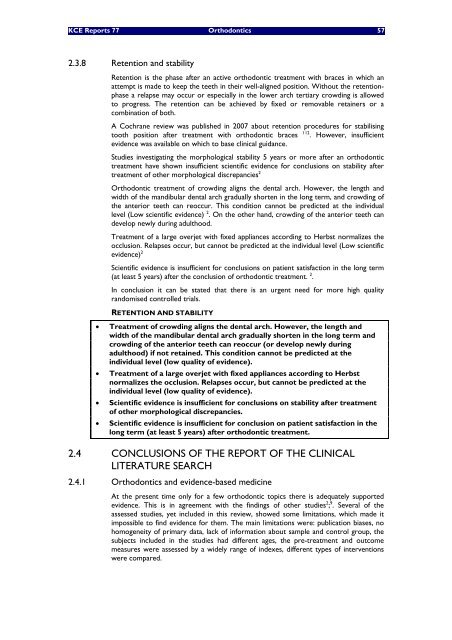The report is available in English with a Dutch summary - KCE
The report is available in English with a Dutch summary - KCE
The report is available in English with a Dutch summary - KCE
Create successful ePaper yourself
Turn your PDF publications into a flip-book with our unique Google optimized e-Paper software.
<strong>KCE</strong> Reports 77 Orthodontics 57<br />
2.3.8 Retention and stability<br />
Retention <strong>is</strong> the phase after an active orthodontic treatment <strong>with</strong> braces <strong>in</strong> which an<br />
attempt <strong>is</strong> made to keep the teeth <strong>in</strong> their well-aligned position. Without the retentionphase<br />
a relapse may occur or especially <strong>in</strong> the lower arch tertiary crowd<strong>in</strong>g <strong>is</strong> allowed<br />
to progress. <strong>The</strong> retention can be achieved by fixed or removable reta<strong>in</strong>ers or a<br />
comb<strong>in</strong>ation of both.<br />
A Cochrane review was publ<strong>is</strong>hed <strong>in</strong> 2007 about retention procedures for stabil<strong>is</strong><strong>in</strong>g<br />
tooth position after treatment <strong>with</strong> orthodontic braces 112 . However, <strong>in</strong>sufficient<br />
evidence was <strong>available</strong> on which to base cl<strong>in</strong>ical guidance.<br />
Studies <strong>in</strong>vestigat<strong>in</strong>g the morphological stability 5 years or more after an orthodontic<br />
treatment have shown <strong>in</strong>sufficient scientific evidence for conclusions on stability after<br />
treatment of other morphological d<strong>is</strong>crepancies 2<br />
Orthodontic treatment of crowd<strong>in</strong>g aligns the dental arch. However, the length and<br />
width of the mandibular dental arch gradually shorten <strong>in</strong> the long term, and crowd<strong>in</strong>g of<br />
the anterior teeth can reoccur. Th<strong>is</strong> condition cannot be predicted at the <strong>in</strong>dividual<br />
level (Low scientific evidence) 2 . On the other hand, crowd<strong>in</strong>g of the anterior teeth can<br />
develop newly dur<strong>in</strong>g adulthood.<br />
Treatment of a large overjet <strong>with</strong> fixed appliances accord<strong>in</strong>g to Herbst normalizes the<br />
occlusion. Relapses occur, but cannot be predicted at the <strong>in</strong>dividual level (Low scientific<br />
evidence) 2<br />
Scientific evidence <strong>is</strong> <strong>in</strong>sufficient for conclusions on patient sat<strong>is</strong>faction <strong>in</strong> the long term<br />
(at least 5 years) after the conclusion of orthodontic treatment. 2 .<br />
In conclusion it can be stated that there <strong>is</strong> an urgent need for more high quality<br />
random<strong>is</strong>ed controlled trials.<br />
RETENTION AND STABILITY<br />
• Treatment of crowd<strong>in</strong>g aligns the dental arch. However, the length and<br />
width of the mandibular dental arch gradually shorten <strong>in</strong> the long term and<br />
crowd<strong>in</strong>g of the anterior teeth can reoccur (or develop newly dur<strong>in</strong>g<br />
adulthood) if not reta<strong>in</strong>ed. Th<strong>is</strong> condition cannot be predicted at the<br />
<strong>in</strong>dividual level (low quality of evidence).<br />
• Treatment of a large overjet <strong>with</strong> fixed appliances accord<strong>in</strong>g to Herbst<br />
normalizes the occlusion. Relapses occur, but cannot be predicted at the<br />
<strong>in</strong>dividual level (low quality of evidence).<br />
• Scientific evidence <strong>is</strong> <strong>in</strong>sufficient for conclusions on stability after treatment<br />
of other morphological d<strong>is</strong>crepancies.<br />
• Scientific evidence <strong>is</strong> <strong>in</strong>sufficient for conclusion on patient sat<strong>is</strong>faction <strong>in</strong> the<br />
long term (at least 5 years) after orthodontic treatment.<br />
2.4 CONCLUSIONS OF THE REPORT OF THE CLINICAL<br />
LITERATURE SEARCH<br />
2.4.1 Orthodontics and evidence-based medic<strong>in</strong>e<br />
At the present time only for a few orthodontic topics there <strong>is</strong> adequately supported<br />
evidence. Th<strong>is</strong> <strong>is</strong> <strong>in</strong> agreement <strong>with</strong> the f<strong>in</strong>d<strong>in</strong>gs of other studies 2 ; 9 . Several of the<br />
assessed studies, yet <strong>in</strong>cluded <strong>in</strong> th<strong>is</strong> review, showed some limitations, which made it<br />
impossible to f<strong>in</strong>d evidence for them. <strong>The</strong> ma<strong>in</strong> limitations were: publication biases, no<br />
homogeneity of primary data, lack of <strong>in</strong>formation about sample and control group, the<br />
subjects <strong>in</strong>cluded <strong>in</strong> the studies had different ages, the pre-treatment and outcome<br />
measures were assessed by a widely range of <strong>in</strong>dexes, different types of <strong>in</strong>terventions<br />
were compared.
















